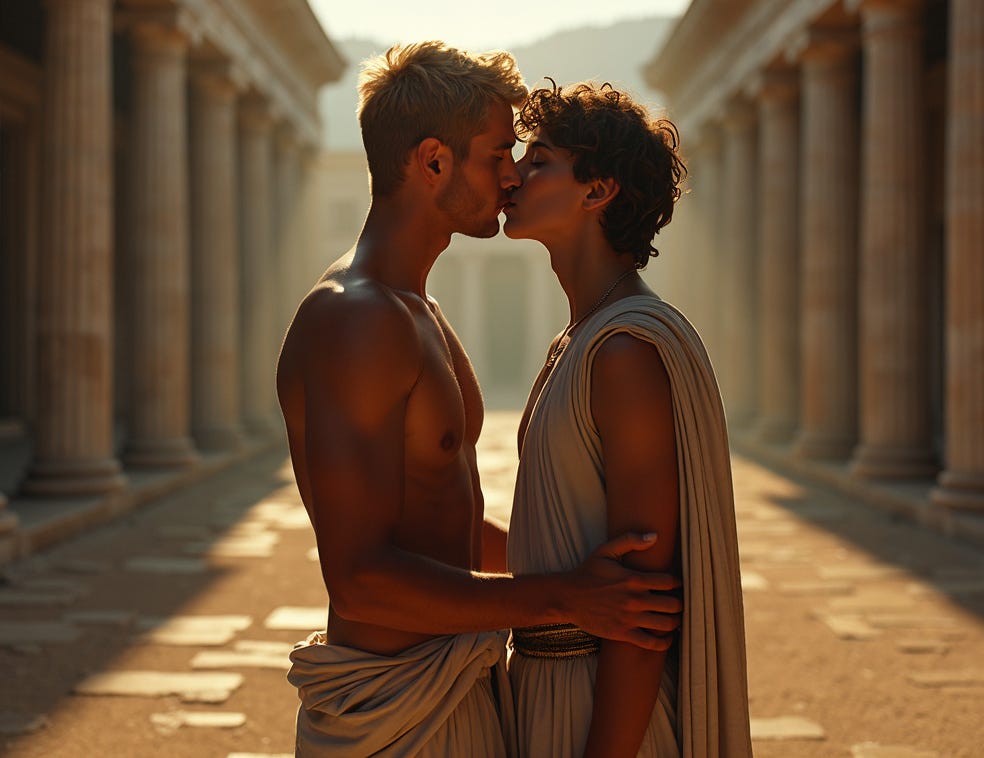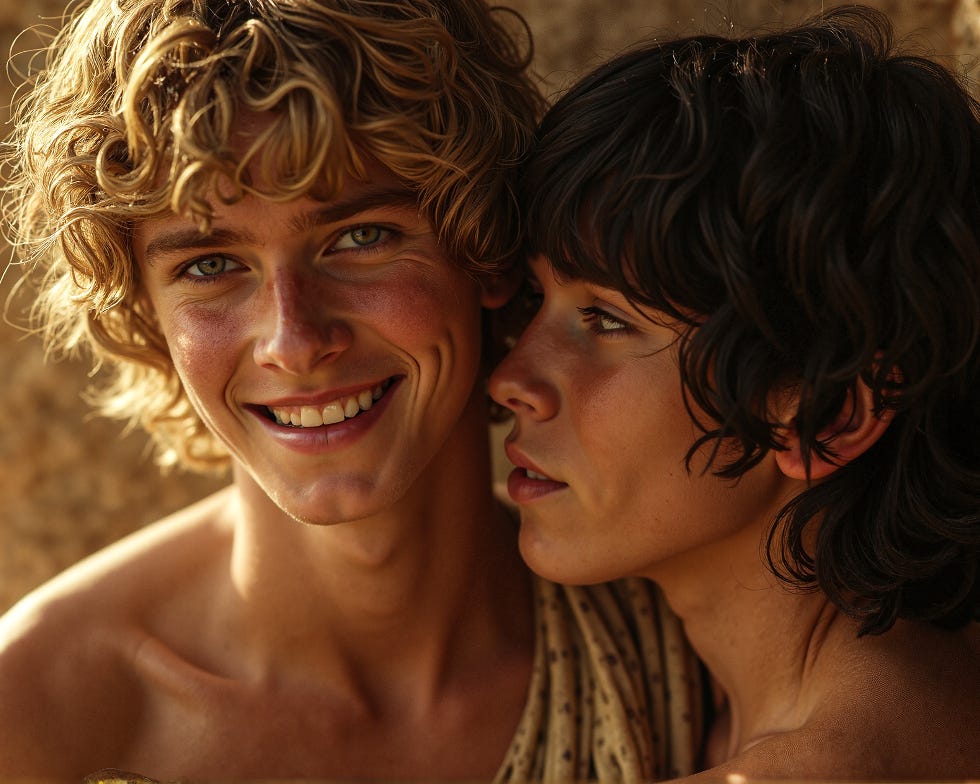The Truth About Gay Relationships in Ancient Greece
Discover the fascinating world of Ancient Greek same-sex relationships, from pederasty to intercrural sex, and learn how these practices shaped queer history.
A World Beyond Marble Columns
When most people think of Ancient Greece, they picture majestic marble temples, robed philosophers, and perhaps a few mischievous gods stirring up drama on Mount Olympus. Yet beneath the shining veneer, Greece was also home to some fascinating—and sometimes downright startling—views on love, sex, and same-sex relationships. The ancient world was anything but prudish, although it operated under cultural rules vastly different from ours. Ready to uncover the secrets of mentorship, erotic poetry, and philosophical musings on queer desire? Let’s jump right in.
Pederasty: Mentorship with Benefits
At the forefront of Ancient Greece’s same-sex relationships is the practice called pederasty, which typically paired an adult male (the erastēs, or “lover”) with an adolescent male (the erōmenos, or “beloved”). By our modern standards, this arrangement is shocking. Yet in its time, pederasty served as a structured mentorship through which the older partner was expected to guide the younger on everything from societal norms to military etiquette. Still, there’s no denying that it contained a sexual dimension.
Viewed through a twenty-first-century lens, pederasty raises serious ethical concerns. Life expectancies were shorter, power dynamics were different, and concepts of consent didn’t align with how we understand them now. Nonetheless, examining pederasty offers insight into how status, public perception, and educational rites merged with erotic desire in the ancient Greek mindset.
A Day in the Life: Mentorship in Action
To better grasp what pederastic relationships might have looked like on a daily basis, consider the pair of Themistion and Aristokles in late 5th-century BCE Athens. Themistion, an accomplished landowner in his early 30s, has assumed the role of erastēs. Aristokles, about 15 years old, is the erōmenos, chosen for his promising intellect and potential as a future citizen.
Morning Routines: At dawn, servants bustle about Themistion’s villa, preparing barley bread and olives. Aristokles may stay in a spare chamber, depending on the arrangement with his family. Over a modest meal, Themistion outlines the day’s lessons—public speaking practice, athletic training, and perhaps a visit to the agora to observe ongoing political debates.
Midday Mentoring: They head to a gymnasium, a social hub where men exercise, study, and philosophize. Aristokles learns proper athletic form, while Themistion encourages him to show discipline, confidence, and the beginnings of a public persona. Later, Themistion might prompt Aristokles to recite lines of Homer or rehearse arguments that prepare him for future civic life—training the younger man’s mind as much as his body.
Afternoon Gatherings: The pair might join other citizens for a light symposium-like gathering. Although these events were often more elaborate at night, an informal midday meal could feature philosophical chatter, political gossip, or poetry recitations. Aristokles mostly listens, absorbing both the content of the debates and the social etiquette that will serve him in adulthood.
Evening Intimacy: As dusk settles and the city quiets, Themistion and Aristokles share quieter moments. The older mentor answers the younger student’s questions about virtue, strategy, and the moral lessons from the day’s discourses. Here, the emotional bond and intimacy of the pederastic relationship become evident; Themistion is both guide and confidant, while Aristokles alternates between apprentice and companion.
This arrangement, while normalized in Ancient Athens, blended mentorship, familial negotiation (Aristokles’s parents presumably approved), and a level of romantic or erotic connection. Modern eyes see a difficult overlap between formal instruction and personal intimacy. Yet for many Athenians, this was part of bringing the next generation into the adult world.
Intercrural Sex: A Different Dimension of Intimacy
Within these pederastic relationships, certain forms of sexual activity were considered more acceptable than others, especially when it came to preserving the younger partner’s social dignity. A practice known as intercrural sex—essentially non-penetrative contact between the older partner and the younger partner’s thighs—was one way erotic desire could be expressed. Ancient sources suggest that this method allowed the older erastēs to experience physical intimacy with the erōmenos while avoiding what many considered the more socially fraught act of anal penetration.
From the Greek perspective, intercrural sex preserved the younger male’s notional “masculine” status. It was also framed as part of a continuum of affection and mentorship rather than something solely about carnal gratification. Again, to our modern sensibilities, it’s a complex dynamic that interlaces emotional, educational, and sexual aspects in a way we find ethically problematic today.
Beyond Pederasty: Adult Same-Sex Relationships
While pederasty garners the most attention, it wasn’t the only form of male-male intimacy in Ancient Greece. Adult men sometimes pursued same-sex relationships with one another, although these arrangements didn’t receive the same ritualized fanfare as pederastic mentorship.
In Ancient Greek society, sexual roles were critical in shaping perceptions of masculinity. Who was active (penetrative) versus who was passive (receptive) could affect one’s reputation. Yet even within these social constraints, philosophers like Plato extolled male-male love for its ability to inspire both passion and intellectual growth—a high-minded perspective that may have stood somewhat apart from everyday realities.
The Female Perspective: Sappho and Women’s Intimacies
Men largely authored the historical record, leaving far fewer glimpses into relationships between women. That said, Sappho of Lesbos provides a key window into female same-sex desire. In her poetry, Sappho expresses longing for other women, hinting at the emotional depth such relationships could carry. Women’s more secluded social standing meant fewer official accounts of their personal lives, but Sappho’s verses underscore that women’s intimacies were also part of the ancient Greek love tapestry.
Different City-States, Different Customs
It’s tempting to treat Ancient Greece as a single culture. In reality, it was a cluster of city-states—Athens, Sparta, Corinth, Thebes—each with its own laws and societal rules. Athenian pederasty, with its careful courtship rituals, might not have played out the same in Sparta, where the military ethic shaped daily life. This regional diversity means there was no singular “Greek” approach to same-sex relationships; attitudes and norms shifted significantly based on location and era.
Why It Matters: Modern Reflections on Ancient Love
One might ask, why does it matter how people in Athens courted each other 2,500 years ago? For one, it challenges the notion that homosexuality is a recent or purely modern construct. In Ancient Greece, homoerotic desire was woven into the fabric of civic life, education, and art, albeit in forms that can unsettle the contemporary conscience.
Studying these customs can also show how cultural rules shape “normal” behavior. Some aspects—like the sincere admiration for male-male love—can feel unexpectedly forward-thinking. Others, like the acceptance of significant age gaps, highlight cultural differences we now find problematic or outright unacceptable. Over the centuries, shifting moral, religious, and legal frameworks would eventually transform how people in this region and beyond understood and judged same-sex affection.
A Legacy of Complexity
Ultimately, the story of gay relationships in Ancient Greece is neither entirely glorious nor entirely grim—it’s a layered tapestry of mentorship, power, love, and desire, unfolding in a world with its own distinct code of conduct. On one hand, homoerotic affection was praised by poets and philosophers. On the other, rigid ideas about status, age, and social roles could create boundaries that feel deeply foreign to us now.
In exploring these ancient customs, we confront a civilization grappling with many of the same universal questions we still ask: How do power and love intersect? Who dictates the boundaries of acceptable romance? And what lessons linger from societies so different from our own?
Next time you admire a Greek statue or recall a passage from Homer, remember that behind those chiseled marble facades and epic battles lay a web of human connections, hidden desires, and evolving social expectations. By peering into that distant past, we enrich our perspective on love, identity, and the ever-shifting line between what society embraces—and what it forbids.







Well written, insightful and clears up a lot of questions about what I thought might have been (ideas shaped by movies and TV)
Thank you.